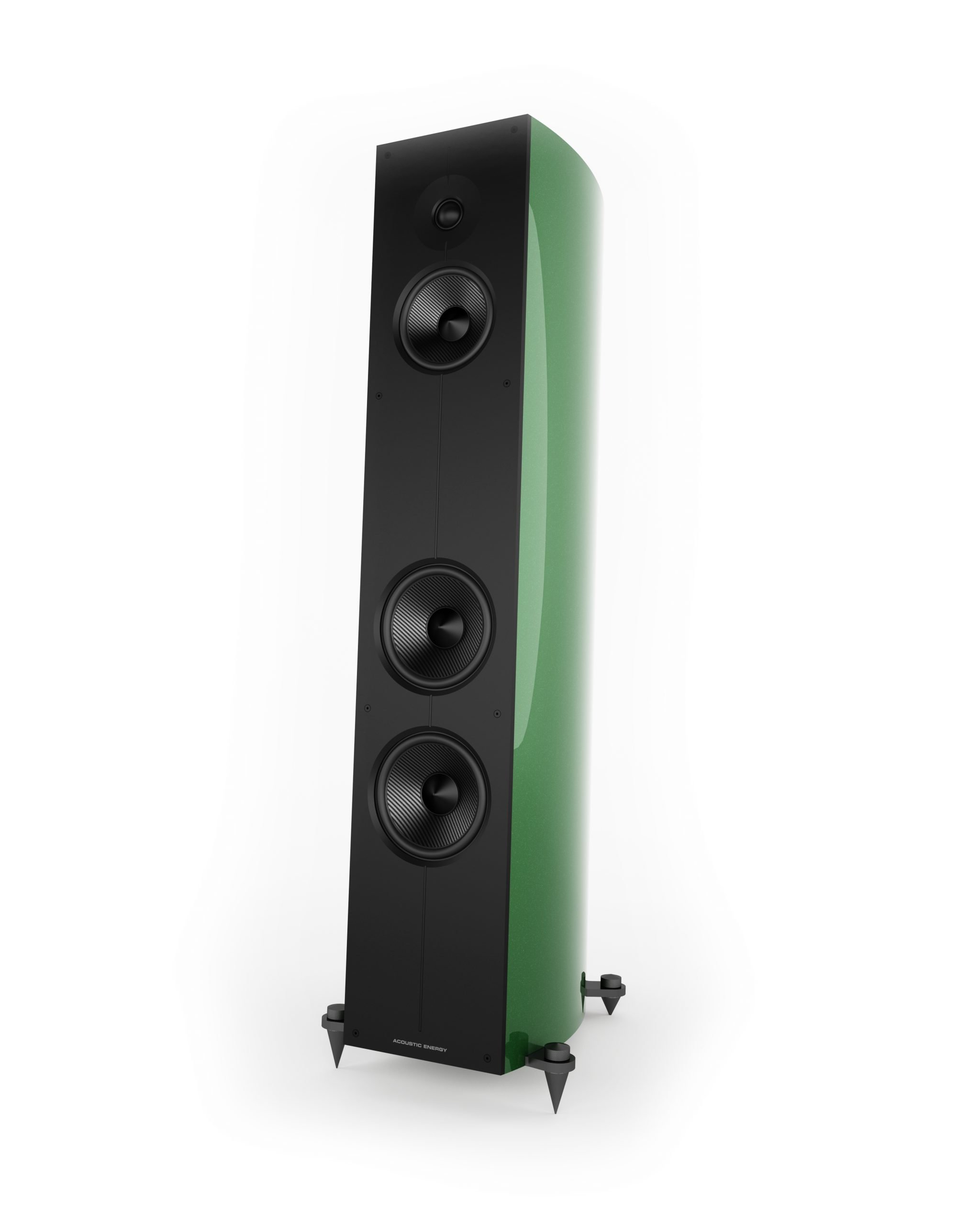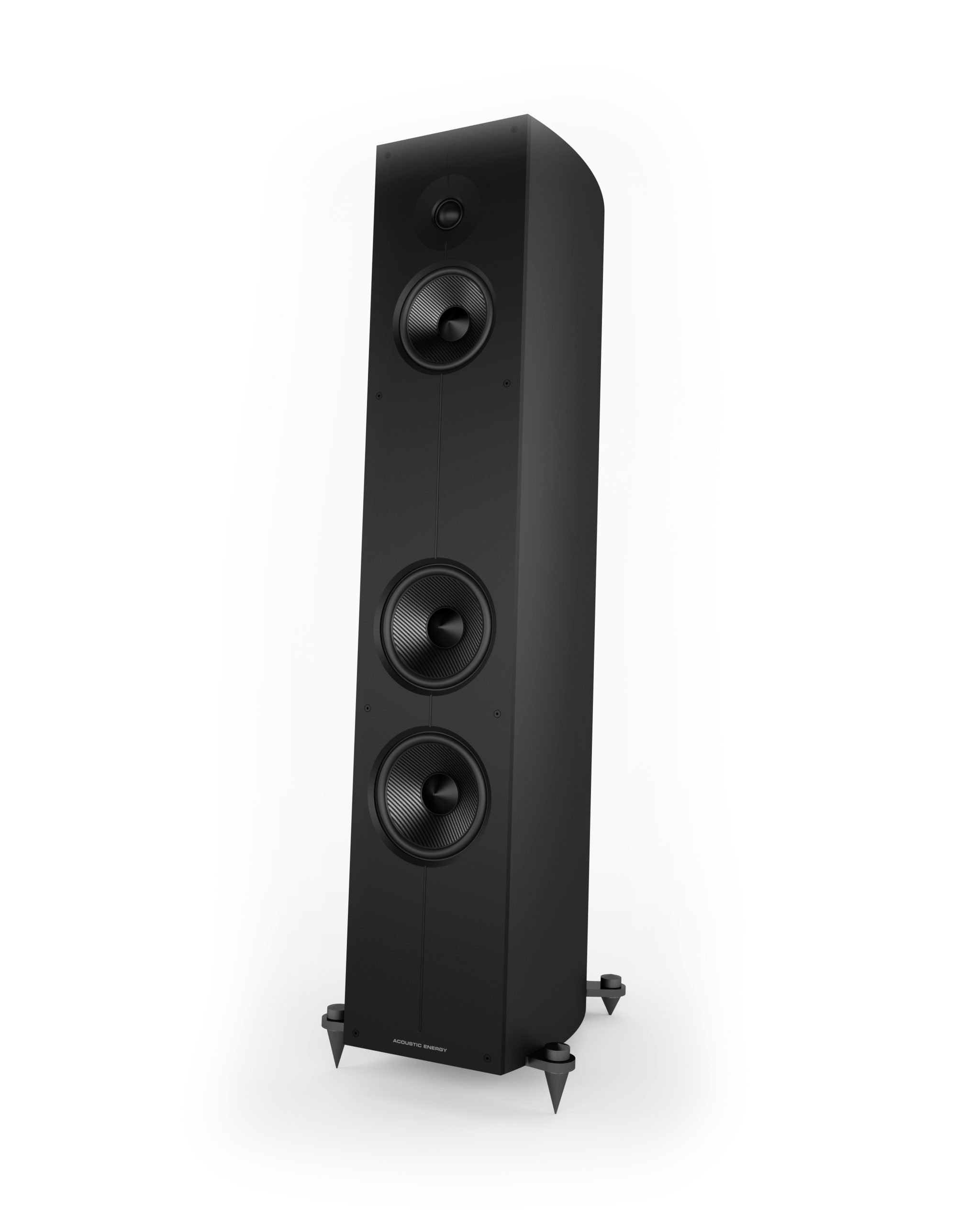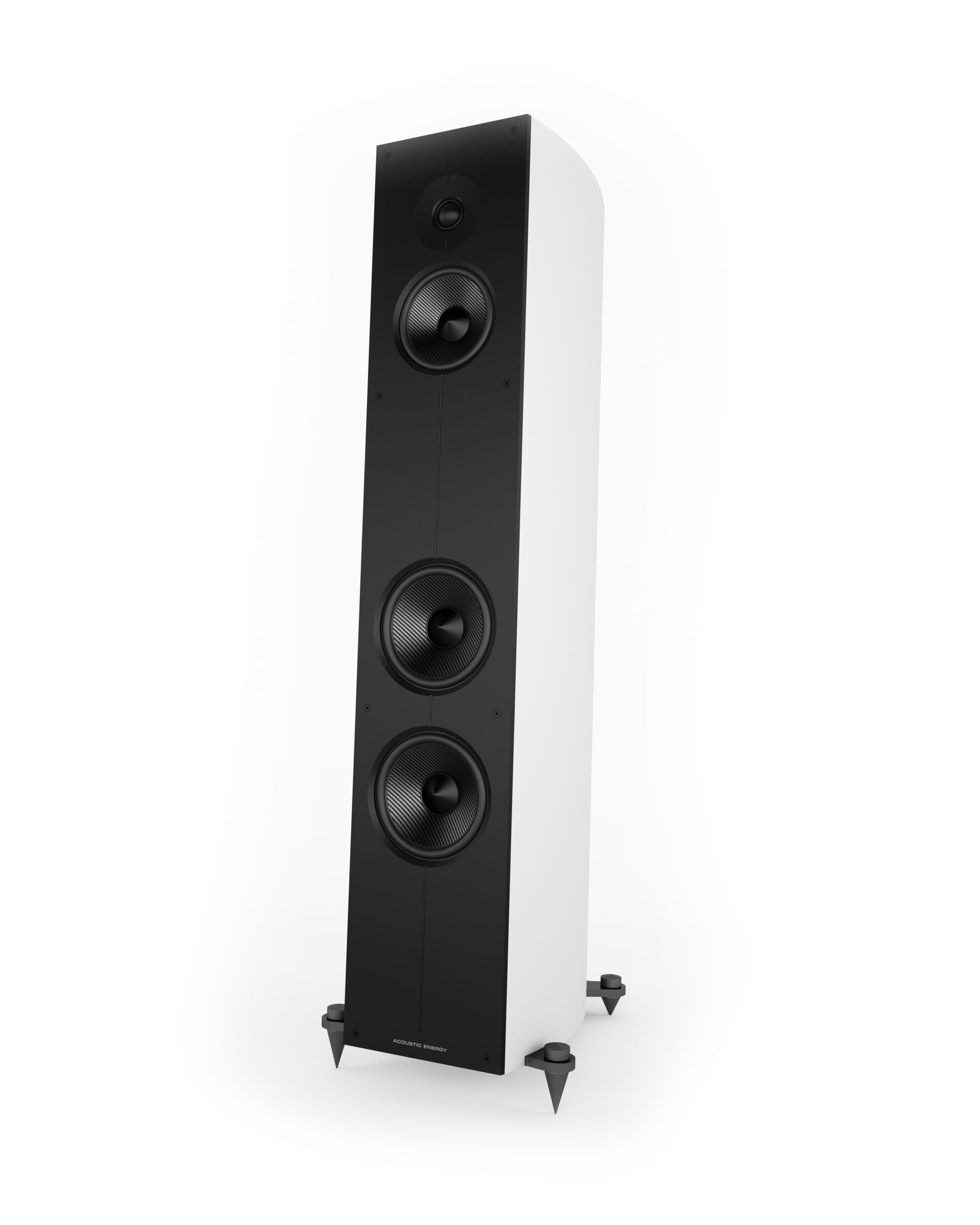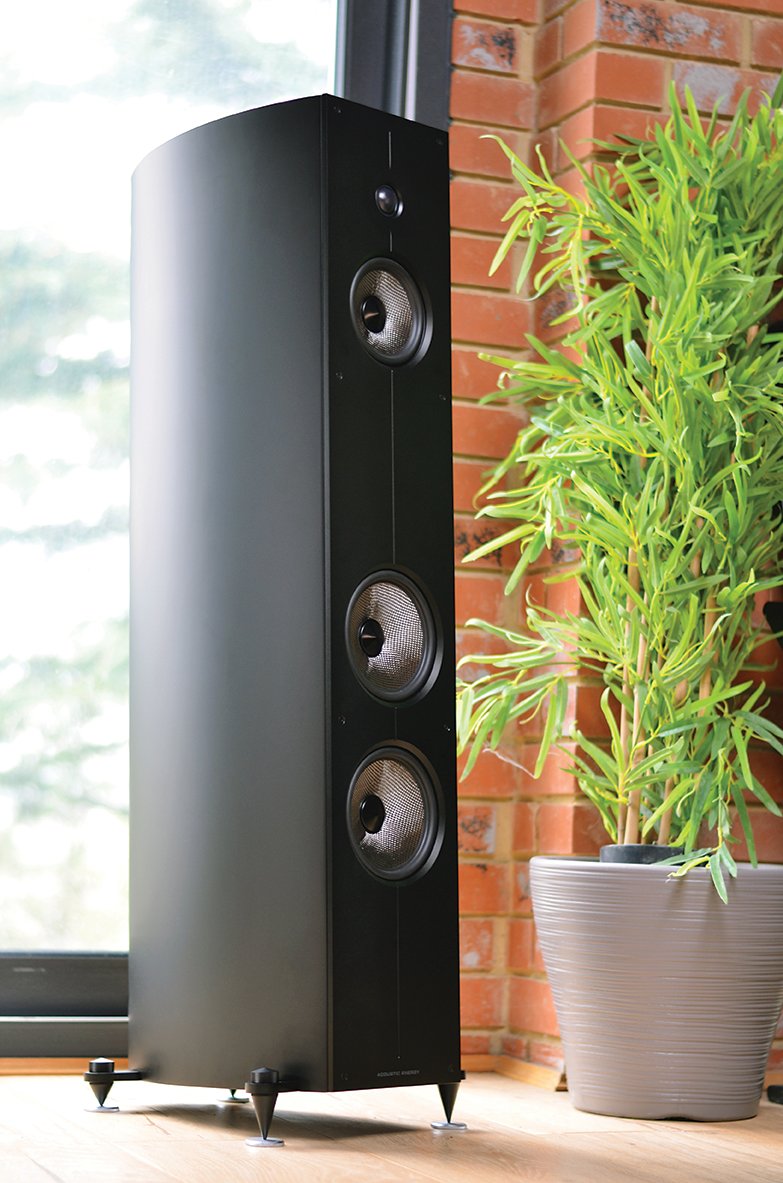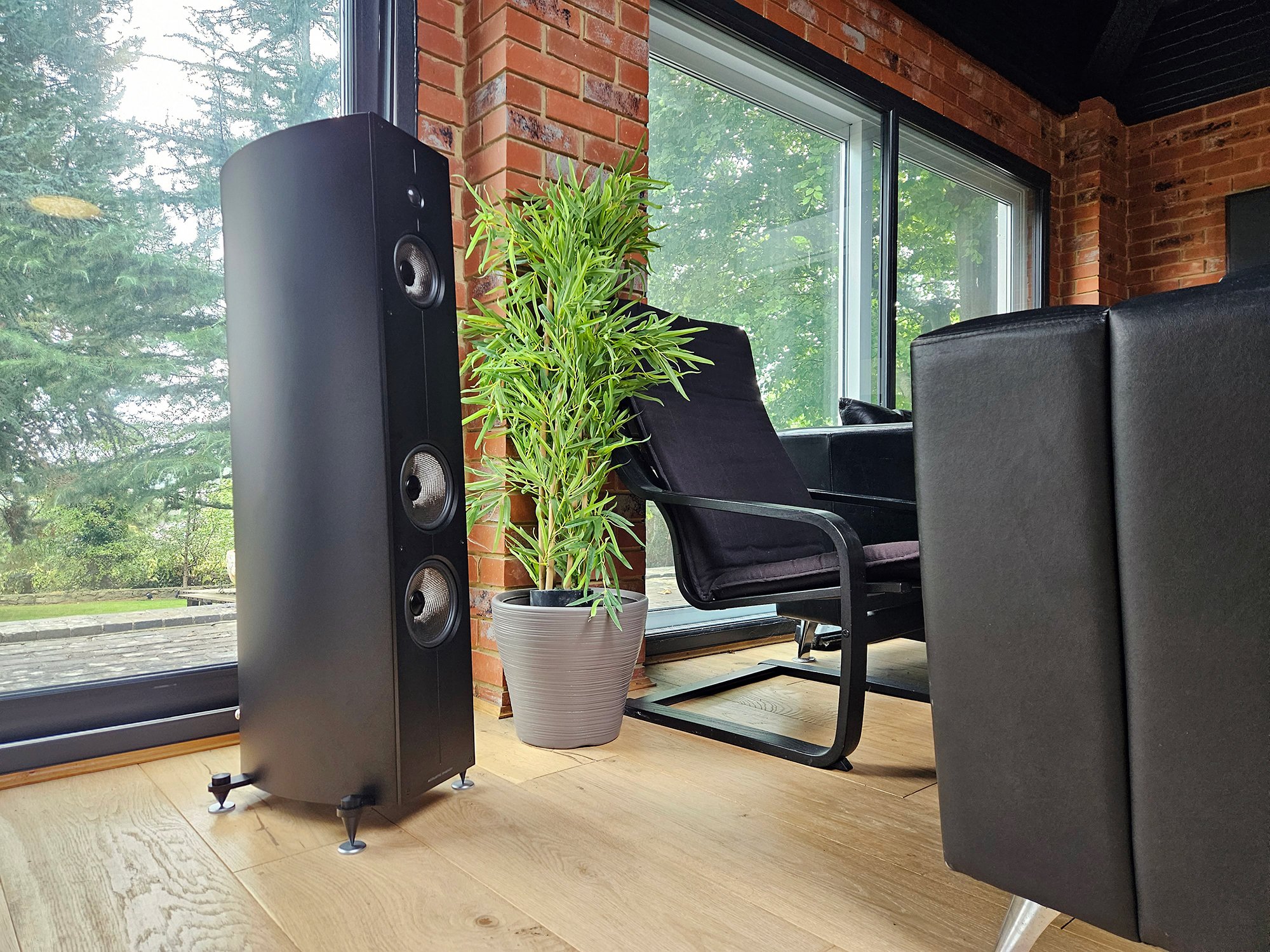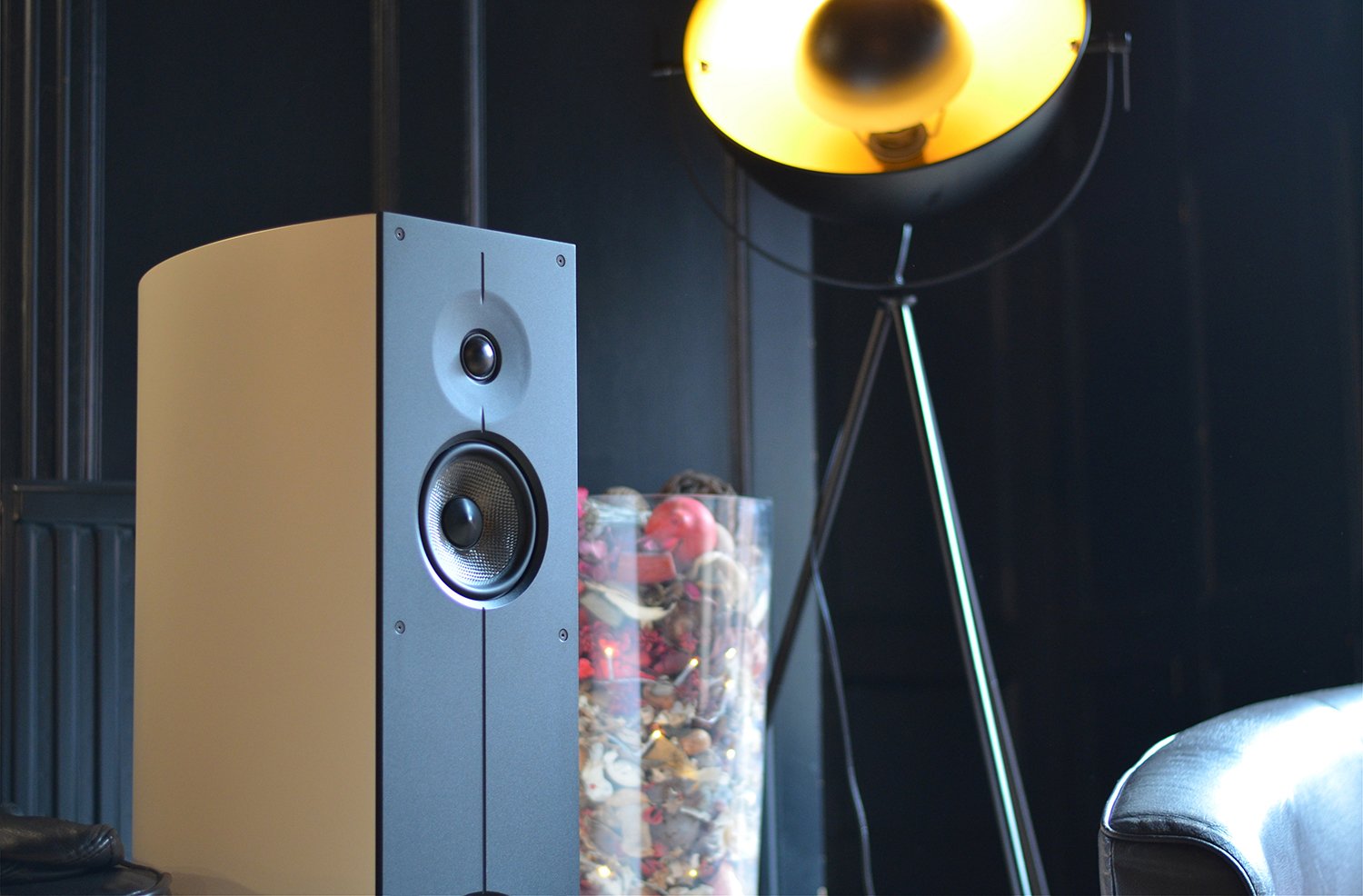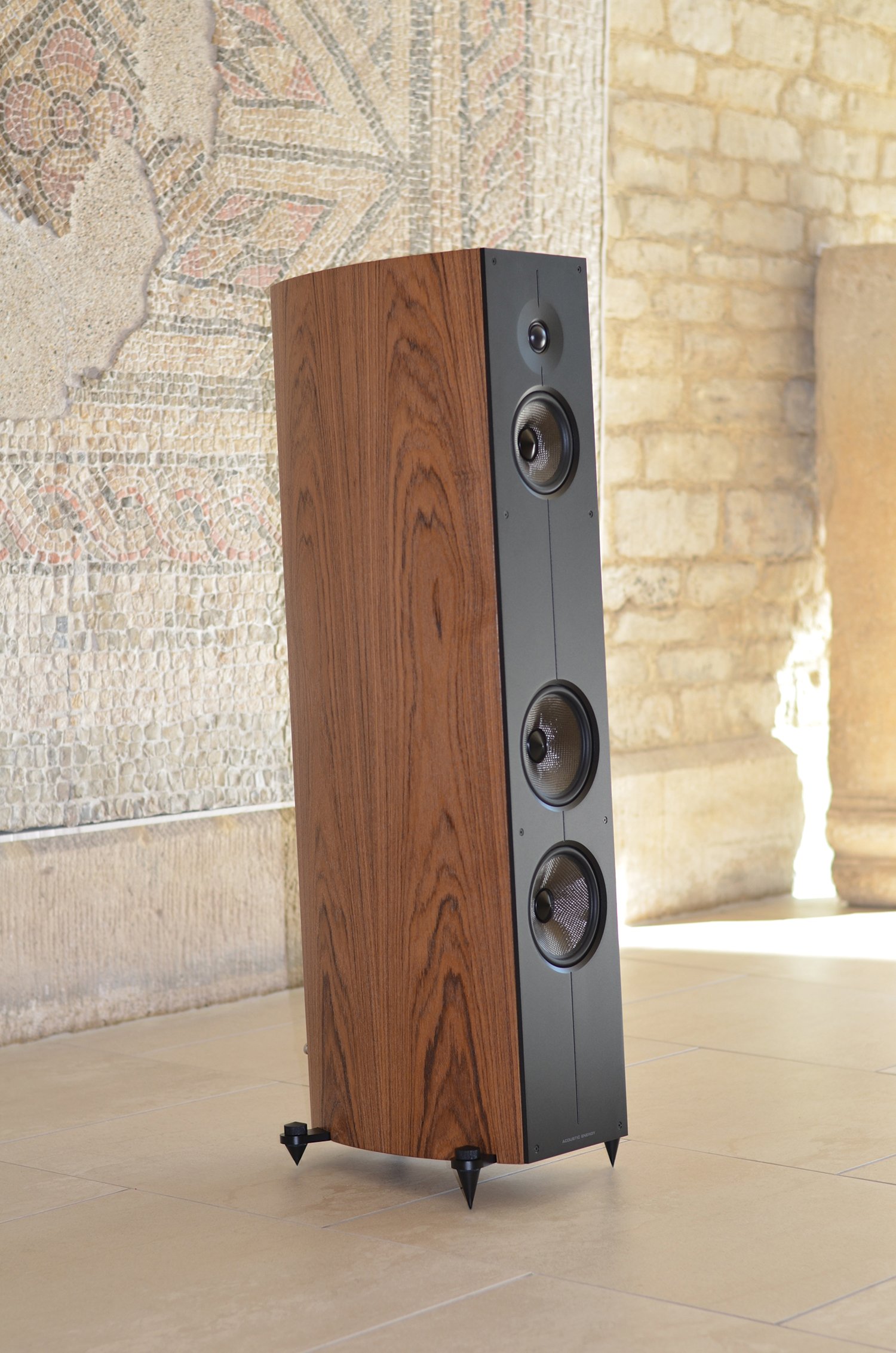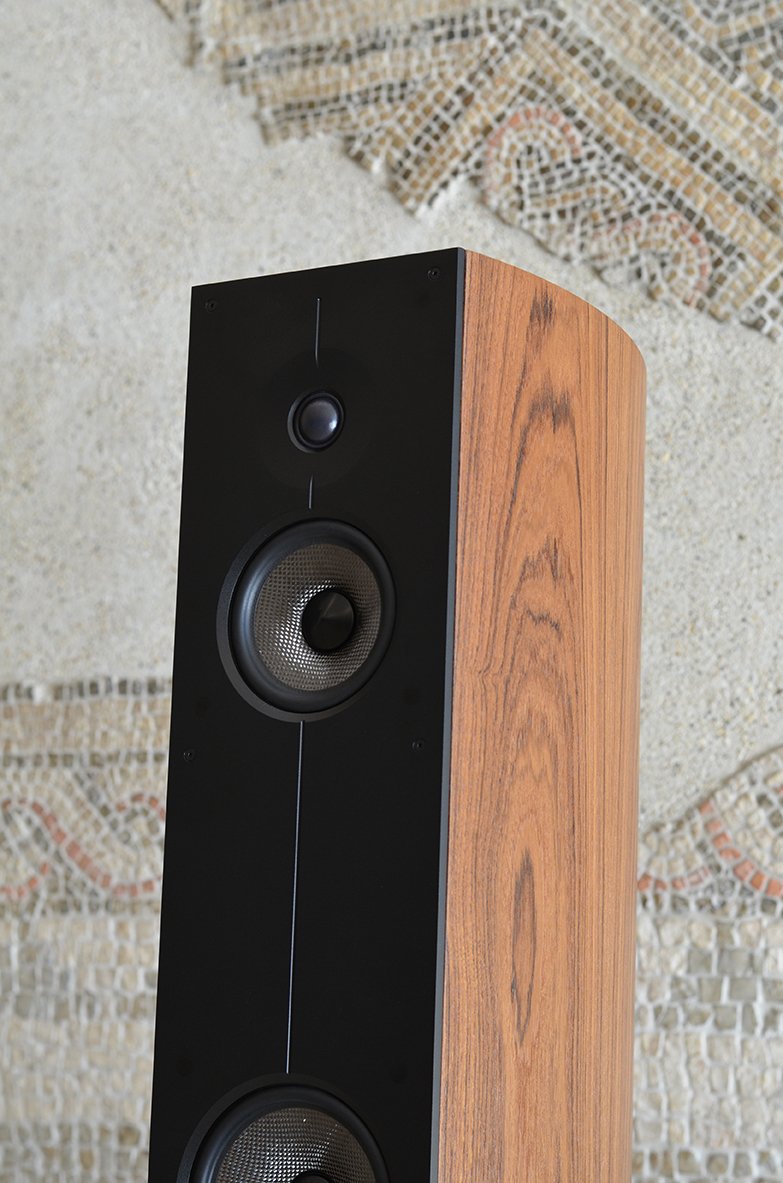Acoustic Energy 'Corinium' Floorstanding Tower Loudspeakers (PAIR)
The Boss
CORINIUM by Acoustic Energy is the latest addition to our award-winning line up of loudspeakers. The culmination of a three-year project for our in-house design team, this brand-new, next-generation floor-standing model is set to establish further new standards in performance, design and value.
SPECIAL ORDER - (Lead time is typically 3 business days)
The Boss
CORINIUM by Acoustic Energy is the latest addition to our award-winning line up of loudspeakers. The culmination of a three-year project for our in-house design team, this brand-new, next-generation floor-standing model is set to establish further new standards in performance, design and value.
SPECIAL ORDER - (Lead time is typically 3 business days)
The Boss
CORINIUM by Acoustic Energy is the latest addition to our award-winning line up of loudspeakers. The culmination of a three-year project for our in-house design team, this brand-new, next-generation floor-standing model is set to establish further new standards in performance, design and value.
SPECIAL ORDER - (Lead time is typically 3 business days)
Specifications
Tweeter
Building on the success of our carbon fibre dome on the 500 series, we identified the need to use an even lighter dome for the Corinium to maximize the transient response of the system. So, we searched for a material lighter than carbon fiber and subsequently sourced a new soft dome material. This newly developed tweeter design has now proven to lower coloration, increase delicate high-speed transients and reproduce the very finest detail and refinement.
Mid and Bass Drivers
At the heart of the Corinium is the midrange drive unit. Covering 5 octaves it’s the key element which produces most of the sound from the loudspeaker system. The new carbon fiber cone and surround helps provide specific tonal qualities we were targeting for this speaker… offering the most natural sound and realistic musical performance. The extra width of the Corinium cabinet allowed us to house a slightly larger bass driver. We went back to basics to develop a brand-new bass alignment that combines weight, speed and slam to produce a natural, realistic sound from what’s still a fairly compact loudspeaker system. In conjunction, we developed a brand new 140mm bass driver to produce a big, powerful, controlled and natural bass sound.
Crossover
Optimized for best transient performance, our 3-way crossover blends the power output of each transducer to provide a rich, tonally balanced sound. High quality components are used throughout including air core inductors, metalized polypropylene film capacitors and metal oxide resistors. The crossover is connected to the drive units using audiophile grade internal wiring which features a patented arrangement of conductors to give the best possible musical detail and dynamic expression.
Cabinet
All these ground-breaking new drive unit and crossover developments are housed in a beautifully curved, exquisitely finished inert enclosure. The hybrid ‘Resonance Suppression Composite’ (RSC) cabinets have a minimum thickness of 22mm and vary up to 50mm for optimal performance. The 4° tilt improves the time alignment of sound to listener, whilst the 6mm ultra rigid aluminum front baffle firmly houses the drivers and isolates any cabinet resonances from the listening environment.
Technical Specifications
Mid-Range Driver | 120mm Carbon Fibre cone
Bass Drivers | 2 x 140mm Carbon Fibre cones
Tweeter | 29mm Soft dome
Design | 3-way reflex loaded with curved RSC cabinet and aluminum baffle
Frequency Range | 32Hz – 30kHz (- 6dB) / 38Hz – 25kHz (-3dB)
Sensitivity | 92dB/m/2.83v
Power Handling | 200w
Crossover Frequency | 260Hz / 3400Hz
Impedance | 4ohms
Connections | 4mm Single wired banana sockets / 9mm spade connections
Spike Thread | M10 x 1.5
Dimensions | 1100mm (inc. spikes) x 235mm x 385mm (HxWxD)
Weight | 40kg (per speaker)
-
We sat down with Managing Director and Designer Mat Spandl to discuss the CORINIUM from conception, through design and production.
What’s the background story to Acoustic Energy Loudspeakers?
Mat Spandl Acoustic Energy MD and Designer
“The company was founded in London, England in 1987 with the creation of the now-legendary AE1 loudspeaker. The AE1 redefined what was possible from a compact enclosure by setting new audio performance standards for dynamics, power handling and clarity previously unheard of outside larger, high-end speakers. These design principals have remained enshrined in the company ethos to this day…
British owned by music lovers, my team and I combine well over 150 years-experience and knowledge in the audio industry with a passion for creativity, performance, build quality and customer loyalty as core brand values.
All our loudspeakers are subject to a rigorous design-process and carry the same DNA that’s run through each product range for over 35 years. New designs are voiced through an exhaustive listening process, with electroacoustic measurement used to verify each step. They’re then benchmarked against our historical references mirroring the dynamics, transparency, tonal accuracy and above all musical involvement necessary to warrant the Acoustic Energy marque.
Right from the start the company has garnered hundreds of awards and accolades from the world’s Hi-Fi press. These and many other endorsements with critical acclaim from journalists around the globe help secure our proud, pedigree status as one of the most highly regarded brands in the audio industry today.”
What made you want to elevate the brand from mid-fi into the high-end specialist audio sector?
“Born from our desire to establish new standards in sound, design and value, the Corinium is the result of a three-year project by our in-house design team and myself. The brief was simple – to create the most dynamic, live sounding and musically involving loudspeaker we’ve ever created.”
… and what type of speaker did you have in mind to help the brand move upmarket?
“We often consider questions such as “What should the ideal loudspeaker look like? Is it a point source approximation? Is it a linear array? What speaker is right for most people most of the time?” Now refine the question and ask, “What’s the point of the cost vs performance curve that offers true high-end performance, just at the point where the law of diminishing returns starts to rapidly accelerate the cost?
Now ask “What’s the ideal sound from a speaker?” Compared to everything else in the chain, source, cables and amplifiers, all speakers have pretty poor performance in terms of distortion of the sound field. With modern components – a laptop and a microphone, it’s simple to produce a loudspeaker with a flat axial sound pressure response for a single point in space. However, considering all the distortions of the sound field, would such a speaker sound natural? Would it sound musical? and would it entertain?
We can consider the LS3/5A. It was a speaker developed by the BBC to provide a natural, convincing reproduction of the human voice when positioned on a stand next to a presenter. They discovered – in order to reproduce male speech from such a compact sized speaker, the axial sound pressure response should not be flat. It’s a clue for the modern speaker designer to consider the relationship between measurement and sound quality is not so straightforward.
So our ideal speaker should sound natural, it should be of reasonable proportions to accommodate a typical domestic environment, it should be expensive enough by using very high quality components to provide true high end sound quality… and it should be finished to a high grade furniture standard. However, it shouldn’t be so expensive for only the very wealthy to afford it.”
So what influenced your design decisions?
“We are Acoustic Energy so our speakers must be musically engaging, have great timing and deliver a sense of dynamics and scale. So what about the configuration? A stand-mount speaker, due to its simplicity can be very musically involving, image nicely and have decent bandwidth. However, such a speaker is limited dynamically and won’t drive a large room. If you consider the footprint of a decent stand-mount speaker plus its matching high quality supporting stand, it’s not so different from a small floor-standing speaker. So we created the optimum middle sized floor-standing speakers by combining large-scale dynamics, with light-footed musicality, an open expressive midrange and excellent rhythm. The result is a fusion of the best characteristics of both stand-mount and floor-standing loudspeakers.”
…and how did you achieve your audio objectives?
“The speaker must deliver a musical performance. Consider a performer, a singer sat on a chair playing a guitar. Where does the sound come from? Assuming there’s no amplification, the mid and high frequency sounds come directly from the mouth of the singer and the strings of the guitar. Then there’s a separate component of the sound, which is the low frequencies, this is the omni directional, room coupled bass sound. Now think of a band with a PA system, these systems typically have the subwoofers turned down low with a top box handling the mid and high frequencies, either pole mounted above the sub, or for larger soundscape, suspended from a truss. It’s a familiar arrangement known to provide the optimum musical result, as it separates the mid-range from the in-room acoustic and avoids the separate bass source and mid frequencies muddying together. The Hi-Fi equivalent to this set up is the stand-mount speaker plus subwoofer system. Although this arrangement is known to offer good results, the main issue which prevents the highest performance is the integration between the speaker and the subwoofer, reflecting the fact that it wasn’t designed from the ground up as a compete system.
So if we design a mid-sized floor-standing speaker featuring mid and high frequency drivers at ear height with a lower subwoofer section to couple to and drive the room, then we could combine stand-mount and floor-standing speaker benefits and produce a source, which is acoustically familiar to live music. If such a source was time coincident at the listening position and designed as a whole system it would offer the best possible integrated sound-field.
This is how we arrived at Corinium.”
What determined your choice of drive units?
“Let’s start with the same carbon fibre drivers used in the 500 Series that offer an impressive blend of mass, stiffness and damping. We knew they could be improved upon even further, so a new cone design was specially developed with a low hysteresis motor system to provide the best efficiency and greatest possible performance – the second generation of carbon fibre drivers was born.”
So let’s start with the high frequencies… a proven carbon fibre formula or a new material?
“The tweeter is an all-new design. Having used carbon fibre in the 500 Series, my team and I decided the moving mass of the tweeter should be reduced to offer the fastest possible high frequencies. So we started to search for a material lighter than carbon fibre and subsequently sourced something highly suitable. This newly developed tweeter design has now proven to lower coloration, increase delicate high-speed transients and reproduce the very finest detail and refinement”.
Our carbon fibre tweeter dome weighed the same mass as our aluminium dome and although much stronger, didn’t need a mesh grille for protection. It also had improved damping compared to aluminium. We looked again at soft dome tweeters and had discounted these for the 500 Series as colouration was too high. Nevertheless we started experimenting with different materials, initially we found a natural silk sourced from Japan, which projected a natural sound and was very light and semi-transparent in appearance. We developed a new motor structure using powerful neodymium magnets, a copper shield on the pole piece to reduce distortion, a profiled pole vent and a rear chamber to control rear radiation with the minimum of damping material that could slow the sound. As with all AE tweeters, we didn’t use ferrofluid in the magnet gap, as it adds unwanted damping and moving mass, which slows the tweeter and obscures detail as well as adding long term reliability issues from the fluid drying over time.
We were quite advanced in our development stage before we discovered the system design had created a level of transparency where small errors in the tweeter’s frequency response were causing unacceptable colourations in the sound. So once again we had to revert to auditioning different tweeter designs and dome materials to find a solution. The result of our extended research was a synthetic polyester material called Tetoron, which when compared to the silk possessed the same moving mass but with a little more stiffness. This meant its shape was retained under excursion resulting in a cleaner, more open sound.
With this tweeter dome also being slightly wider than (our) normal designs we found the correct balance of in-room high frequency energy for the most natural sound could be achieved with a very shallow waveguide. This guide offered just the right blend of diffraction at the highest frequencies to ensure wide directivity and shade the tweeter from reaching the edges of the speaker cabinet… which would otherwise create points of secondary radiation and interfere with the frequency response.”
…and a new material for the mid-range driver too or retention of carbon?
“The mid-range driver covers five of the eight available octaves of audible sound. If the loudspeaker was to provide a simple acoustic source then it should rely on the mid-range driver for the widest possible frequency range. This means the frequencies where the ear is the most sensitive to disruptions caused by the phase shifts of the crossover are pushed to the limits. Further-more we found basic characteristics of the mid-driver when heard in free space, more or less survive the final system design, so to achieve the highest quality sound reproduction it was important to develop a mid-driver with the best possible sound quality.
With our 500 series we found the carbon fibre cone had a good blend of mass, stiffness, and damping which made it very suitable as a cone material. We evolved the shape of the cone a little to greatly improve the break-up behaviour. The break-up of a cone refers to the (usually out of band) peaks in the frequency response, which although attenuated by the crossover filter, are largely responsible for the characteristic colouration associated with a specific cone material. So although our carbon fibre cone used in the 500 series had been praised by the hi-fi press for its neutrality and low colouration, we felt further improvements could and indeed have been made to reduce these levels even further, allowing us to use more sympathetic crossover slopes which have lower phase shift compared to the more aggressive slopes, that are sometimes required to attenuate cone break up behaviour.”
And finally the all-important bass system… how have you managed to combine power with control?
“The key element of a bass system is of course the woofers. We developed a brand new 140mm version of our carbon fibre cone, which is very stiff and has excellent power handling with durability. A brand-new low hysteresis motor system was also developed to produce the best efficiency and greatest possible speed.
The bass system on the Corinium is a complete reworking compared to the previous generation of speakers, which the AE520 was the pinnacle of. We went back to basics to discover what listeners’ value as musical enjoyment. We looked at the relationship between fundamental notes and their harmonics, how room loading works, and looked at the psychoacoustic response to room gain… which is the ‘extra’ bass added by the room through resonant modes, and finally we looked at typical listening levels.
The result is an alignment, which is outside of text-book responses. Most of the important bass weight and speed is dealt with solely by the woofers. The port is tuned much lower than normal and only exists to underpin the output of the woofers. In this way we blend the good points of a sealed box bass system i.e. the speed, slam, and rhythmic tune playing, with the advantages of a reflex bass system which is more compact in design and boasts improved power handling. So we’ve created a bass system that’s compact in size but plays a tune, has the correct balance of fundamentals and harmonics to offer a natural sound… and has sufficient weight in the low registers to infer a significant sense of scale.”
Tell u about the crossover design?
“Tying together all the elements of the system is the crossover filter. The Corinium is a 3-way design so there’s one pair of filters for the bass to mid-range and another pair for the mid to top range. As is typical in most passive speaker designs the crossover filter also takes care of the equalisation of the system to an even frequency response, which accounts for the dimensions of the cabinet and of the radiators themselves. Integral within the art of speaker design is fine tailoring of the frequency response to produce a natural, dynamic, entertaining sound, quite separate from the mathematical result that dictates the ’flattest’ response or follows some other textbook curve. It’s what separates the great speaker designs from the also rans and can only be achieved through listening and experience.
The Corinium uses largely second order crossover filters, which are electrically blended with the drive unit responses to offer the best possible integration of power and phase. We discovered low filter phase shift is desirable, as is good time domain performance, so we’ve designed well damped filters that don’t ring in the time domain or introduce large phase shifts which may be heard off the main listening axis and create holes in the response, leading to an unnatural room sound.
In our choice of crossover components we carefully evaluated which component choices have an effect on the final sound quality and matched each component type to its intended function. All series inductors are air core where you need the lowest possible distortion. Although they could be made to be very low loss, we found iron core inductors coloured the sound and made the speakers balance level dependent. We use film capacitors throughout and on the critical tweeter capacitor we used a branded product, selected from a number we tried and selected the most open, natural sounding model. We’ve always preferred metal oxide resistors over the traditional cement units for a more dynamic, open sound, depending on where they’re used in the circuit.”
Internal cabling can often contribute to the overall performance, so what’s been used to connect the crossover to the drivers?
“The crossover PCB is of a high quality and features a thicker copper deposit compared to the rest of our range. It’s wired to the drive units and binding posts using audiophile grade oxygen free copper cable supplied by Wireworld Inc. from the US. The cable is specifically developed for internal speaker wiring and features a patented layout of conductors for neutrality and openness. Although less convenient than the usual spade connectors we wanted the best possible connection quality, so the wires are connected by soldering directly to the drive unit terminals.”
Why are they not bi-wired?
“As with all our products we offer a single pair of speaker terminals. We believe it’s possible to obtain optimum results using a single pair of high quality speaker cables rather than two pairs of lower quality cables… and we avoid the unreliability of bridging links.”
What’s special about the cabinet construction and why go for a stunning curved design?
“All our groundbreaking new developments in drivers and crossovers are housed in a beautifully curved and exquisitely finished cabinet enclosure. These hybrid Resonance Suppression Composite (RSC) cabinets have a minimum thickness of 22mm and vary up to 45mm for optimal performance. The 4 degree tilt improves the time alignment whilst the 6mm ultra rigid aluminium front baffle houses the drivers”.
In order to meet the requirements of the specification we designed the slim cabinet, which for the first time since we launched our Radiance series 15yrs ago features a curved profile. The reason we went for a curved profile was to help the cabinet blend acoustically into the listening environment by encouraging sound to diffract around it rather than large flat radiating areas causing extra reflections in the listening environment. In order to achieve the level of very low cabinet radiation, we constructed the large side panels of the enclosure using our Resonance Suppression Composite structure used in our 500 series which produces the right blend of mass, stiffness, and damping to dramatically reduce cabinet radiation, compared to more usual wood-based materials, typically used in loudspeaker cabinets. These thicker (22mm) side panels further reduce sound radiation and are mounted in a large clamp that’s formed by a spine running up the rear of the cabinet with thick 50mm top and bottom plates.”
The front baffle looks to be separate from the cabinet… was the objective driver accuracy?
“The front baffle is made from two separate materials. Firstly there is a 25mm MDF panel, which provides an inert surface to house the mid-range and woofers in addition to tying together the side panels of the cabinet. The second element of the front baffle is a 6mm thick solid aluminium plate, which is bolted to the ‘wooden’ part of the cabinet to provide a final inert surface with very high stiffness and very low surface radiation. The tweeter is bolted directly to the aluminium baffle to provide some isolation from any resonance caused by the mid and bass drivers.”
How have you coupled the speaker to the floor and why the tilt angle?
“The cabinet is mounted to the floor using a similar bar and spike arrangement to the 500 series. We found this design offers a reliable, stable base, which is very effective at transmitting waste energy away from the cabinet and into the floor. For the Corinium we have shortened the rear spikes to provide the 4-degree tilt to the cabinet. This is designed to aid time alignment of the drive units to ensure the arrival time of the sound from each driver to the listeners ears is as close a practical, helping to ensure the speaker presents a simple acoustic source.
The cabinet also features a dedicated vented chamber to house the mid-range unit. Internal acoustic damping is used and kept to a minimum to promote a fast open sound. A vent was added to help reduce the peak pressure in the cabinet. It’s then damped with an acoustic stuffing to avoid any organ pipe resonance and reduce the mid-range leakage into the listening environment.
The bass chamber is loaded by the large slot port, and again features minimum internal acoustic damping, positioned to reduce the cabinet modal resonances whilst keeping the bass energy intact.”
So based on the CORINIUM specifications, what would you recommend as the ideal partnering equipment?
“The Corinium has a high sensitivity of 92dB/2.83V with a 4ohm average load. This arrangement offers the maximum headroom from a given amplifier’s voltage output, assuming it has adequate current capability. Amplifier specifications are not usually clear on this issue. Since 1 watt of power will produce 92dB 1m away from the speakers (very loud), amplifier power is required for dynamics rather than for steady state sound level. This means the amplifier must only produce large voltage peaks for a short amount of time and subsequently, very unlikely to produce any thermal limiting under most normal operating conditions. The important measure is the short-term peak current delivery to show that it’s capable of reproducing dynamics without current limitation. The rule of thumb is if the amplifier can double its 8 ohm output power into 4 ohms then it should offer sufficient performance. To experience full-scale dynamics and realise the best performance from the speakers, our recommendation is for an amplifier that’s rated at 100W or more into 8 ohms. However, if you only listen at low volumes then less power may well be sufficient.”
So in summary how have you’ve achieved the final result?
“By tearing up our previous rule book and starting with a blank sheet of paper, we’ve examined each area of music reproduction over the past three years. We’ve chipped away at the problem resulting in small gains in each area. When added together these small gains have resulted in a speaker, which is markedly more dynamic, more live sounding, more musically involving compared to the previous generation of products. It’s been an exhaustive process examining each element and its relationship to the whole. We tried to avoid spending time and effort on the areas that matter less and instead, invested time and money on areas we found offered us the largest gains.
You’re beginning an audio journey that’ll provide decades of discerning listening pleasure, whether new to our brand or upgrading. You’ll join an exclusive club with the assurance of British design and engineering at its very best, backed by an industry-leading warranty support programme. We think we’ve produced something which not only compares well with its competitors but actually goes beyond that and offers something more sophisticated, more musical, delivered in way previously only available in a rarefied space occupied by the select few.”
…and finally, why the name CORINIUM?
“Cirencester in the beautiful English Cotswolds, our hometown for more than 25 years was an important outpost in Roman Britain. In fact it was the most important town outside of London. They named it Corinium and we’re proud to name our most significant and impressive loudspeaker to-date after our own hometown.”
-
The Absolute Sound
December 2024
Reviewer: Tom Martin
Full Written Review
Full YouTube Review“I was impressed by how similar the Corinium sounds to my reference Magico A5s. now, the Magicos cost about $19,000 more per pair. I could provide a list of places where the A5 outperforms the Corinium, but these are mostly matters of degree, like more even midrange and treble balance that leads to smaller octave-to-octave variations or more fine-grained harmonic detail. There are also differences in the mid-bass balance due to different choices about how to compensate for room gain. If you have excellent sources and amplification, and you care a lot about these features of music, the A5 is a good value if you have the money. If not, and you can afford the Corinium, it gets you surprisingly close to a widely praised but more expensive speaker. All this assumes the voicing fits your approach to music.”
Hi-Fi+
December 2024
Best Floorstanding Loudspeaker over £5k Award
Reviewer: Ed SelleyApril 2024: Full Review (PDF Download)
September 2024: Hall of Fame (PDF Download)
December 2024: Best Floorstanding Loudspeaker over £5k Award (PDF Download)“This speaker does things that I haven’t always associated with Acoustic Energy, and it does it well enough to ensure that it earns its admission to the price point it contests without a shadow of a doubt. The most impressive part of it all, though, is that it has done that without forgetting where it has come from.”
Part-Time Audiophile
July 2024
Reviewers Choice Award
Reviewer: Marc Smazik
Full Review“Which brings me back to the “Corinium problem.” What should I compare these to? Von Scheiweikert Endeavor RE’s have more air and space, at 3x the price. Magico A5’s have cleaner mids and a bit more boogie, at 4x the price. Acora SRBs disappear in the room better at 2x the price. I have honestly been racking my brain, and putting off writing this for weeks because I do not know what to compare these too at anything less than double the price, which I think is the point that Acoustic Energy is making here. They are putting the industry on notice that big money does not always equal better. The Acoustic Energy Corinium speakers are special. Please go listen to them.”
Hi-Fi Choice
April 2024
Editor’s Choice Award
Reviewer: Nick Tate
Full Review PDF Download“This is the best Acoustic Energy speaker I’ve heard, and that includes the legendary AE1 from back in the eighties. It offers excellent performance at the price and is a massive upgrade over the company’s previous ‘flagship’ floorstander, the AE520. The latter is almost half the price, but the Corinium is more than twice as good.“
Stereonet
January 2024
Product of the Year Award
Full Awards Listings“Going up a size, to enter the ‘affordable high end’ loudspeaker market was without doubt a gamble for Acoustic Energy, which has of late focused on less expensive designs. On the face of it the new Corinium is basically an upscaled 520 floorstander, but look closer and you’ll see a host of improvements and refinements that ratchet up the performance dramatically. Artfully designed and beautifully constructed, the result is a very powerful but subtle performer that is highly musically enjoyable yet super-refined. A real class act, right now this is near-impossible to beat at the price.“
The-Ear.net
February 2024
5 Stars
Reviewer: Jason Kennedy
Full Review“The combination of speed, power handling and transparency to detail is intoxicating with a good piece of music and really engages the senses in a way that more laid back speakers cannot.”
“I got some exhilarating results with these speakers, they consistently managed to dig deep into each piece played and brought out the power, the emotion and the scale of each.”
AVForums
April 2024
Reviewer: Ed Selley
Full Video Review
Full Written Review“For me, the truly immersive quality of music is rhythm. I can be sucked in by lyrics and instrumental skill but, when all is said and done, it’s the beat that matters. The Corinium is a metre tall bright green love letter to people who think like me.”
Diapason d’Or
March 2024
Reviewer: Vincent Cousin
Full Review (pdf)“If you want to play the piano-cello duet at concert level without compression, this power is required without delay. Thus managed, the Corinium demonstrate a real foundation and with a dazzling attack. These are speakers hyper neutral, with a tendency monitor, without coloring, also able to draw a space grandiose sound, as breathable as the taker of his wanted it, no more and, above all, no less.”
Hi-Fi Voice
June 2024
Full Written Review
“… can play surprisingly physically and unexpectedly deep, even in a very tight and agile form, so he does not seem heavy. If you’re looking for something analytical but not technical, then the Acoustic Energy Coriniums are brimming with information, drive and determination to play in whatever context at a fair price.”Gedeon Audio
May 2024
Full Video Review
Full Written Review
“The presence experience is absolutely top-class, emotional and intimate, but with market-leading control and detail.”Analogholic
April 2024
Full Video Review
“If you are looking for speakers in this price range or maybe even under 10,000 USD and you want to experience the dynamics, the power of live music with all the resolution the best recordings have to offer then you should seriously consider the Corinium.”Audio & Vision Online
March 2024
Full ReviewConclusions:
• A warm-toned, bass-rich, lively and natural performance
• It bears all the character of its manufacturer, but is clearly already at the top of level of the audiophile region
• He does not choose between musical genres, he touches everything enthusiastically and unflinchingly
• Softly, at room volume or loud, this speaker provides a sense of presence at all levels
• Very carefully designed, rigid and stable construction, with excellent use of materialsHiFi.nl
January 2024
5 Stars
Reviewer: Harro Tillema
Full Review“Acoustic Energy has introduced a beautifully finished floorstander with its new Corinium speakers. The limited edition in British Racing Green metallic in combination with the black front, base and drivers visually leaves us with a stately impression.”
“An attempt has been made to create new standards in the areas of sound quality, design and price-performance ratio. Let us already reveal that we believe that the manufacturer has succeeded in its aim here with distinction.”
“Despite the spatial representation and the multitude of instruments, we do not experience a confusing scene, but rather a high degree of order and realism.”
“With this pricing, Acoustic Energy puts their new Corinium speakers on a very interesting price point, and they will be a formidable competitor to the competition in this price class.”StereoNET
November 2023
Applause Award
Reviewer: David Price
Full Review“This is one seriously special-sounding loudspeaker.”
“There’s no banging, booming or thrumming from that big cabinet; instead, this speaker sounds as tight and together as the classic AE1 standmounter ever did.”
“Allied to the Corinium’s smooth treble, velvety midband, and grippy bass is the ability to reproduce a stereo soundstage with superlative accuracy. It images brilliantly”
“This superb new loudspeaker is not only Acoustic Energy’s finest-ever design, in my view, but also one of the best mid-price bargains on the market right now.”
AV Mentor Greece
February 2024
Full Review“The overall character of the speaker is impeccably designed. Fast and full in the lows, balanced and at the right distance from the listener in the mid-range and appropriately gentle in the highs, it created – with impressive comfort – a restful feeling of fullness. The speaker seems capable of playing everything, forgiving a slightly projective program and displaying all the niceties of a careful production. You can’t ask for much more…”



